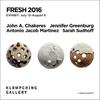The Back-Story on Chinese Works of Art in Gianguan March 11 Sale
- NEW YORK, New York
- /
- February 17, 2017
Gianguan Auctions’ offers Asia Week buyers an impressive array of historic and contemporary Chinese paintings, ceramics, jade and stone carvings–all of which relay the ideals, accomplishments and aesthetic advances of a culture that gained artistic sophistication before the Bronze Age dawned.
Collections can be viewed now at www.gianguanacutions.com. In-gallery preview opens Friday, March 3rd at Gianguan Auctions’ mid-town gallery, 39 W. 56th Street. The sale is Saturday, March 11th, starting at 10 a.m., the first weekend of Asia Week.
Hghlights begin with Chinese ceramics that epitomize Chinese artisans’ mastery of potting hard-paste porcelain and decorating it with complex layers of glazes.
The magnum opus is Lot 128–a black glazed bottle-neck vase of the Qing Dynasty elaborately enameled with gilt wire outlines on a field of Famille rose. Six Buddhist lions, florals and acanthus leaves are set off by a gilt key-fret rim. The blue reign mark and the Qianlong six-character mark are on its base. The estimate is “by request”.
Lot 97, a refreshing Wucai fish jar with cover reflects the porcelain preference of Ming emperors Jiajing, Longqing and Wanli. The depiction of golden carp in a lotus pond plays out on a blanc-de-chine ground with underglaze blue enlivened by enamels of golden yellow, green, red, brown. Free-form flourishes attest to the high standards demanded of court artisans. The sturdy, globular jar is early Ming, with Jiajing six-character mark. It is valued at $3M.
The second cover lot is , “Gathering Beneath the Sycamore Tree,” by Qiu Ying (1495-1552). It is painted in the gongbi (realistic) style and evokes a slice of life among women of the Ming court. Colorful, detailed, and a joy to view, it also surfaces, in the vapid expressions of the beauties’ faces, the inherent submissiveness in the role of women of the time. Signed Qiu Ying, with one artist seal, seven emperors’ seals, six collectors’ seals and colophon by Gao Shiqi, Lot 72 is estimated at $1.3M.
Tang Yin (1470-1523), one of the “Four Masters of the Ming Dynasty”, painted “Visiting Friends,” an outsider/insider peak into a humble, rural house whose master is about to receive the guest entering the gate. It is Lot 103, inscribed, signed Tang Yin with two artist seals, twelve collectors’ seals and six emperors’ seals. Colophons are by Pan Zhengwei, Liang Shizheng and Qian Chenqun. Estimate is upwards of $500,000.
Jade, once prized more than gold, silver or bronze, has not lost its appeal to collectors. Lapidary techniques mastered by Neolithic craftsmen deliver some of the most desirable carved jades in the sale.
For example, Lot 123 is a Warring States ritual vessel of polished dark brown jade with variegated hues. Modeled after a bronze pan, the exterior of this shallow water dish is incised with dragon patterns. Its rarity warrants a starting bid of $12,000. Meanwhile, Lot 124 is a flanged jade disc of the Dawenkou culture once used as a symbol of heaven and power. It is valued at upwards of $10,000.
Personal items and jade jewelry open the sale. GIA certified properties include, Lot 7 an elegant, cylindrical jadeite bangle of translucent green with vivid emerald streaks. It is valued at $20,000. Lot 8, a handsome jadeite and diamond ladies’ ring, is set to go off at $12,000. Lot 9, a jadeite bamboo pendant with an auspicious silver squirrel atop, will fetch about $5,000.
Carved in concert with their natural form, small jade sculptures and touchstones resonate with creativity and skill. Lot 20, white with green inclusions, shows the three generals from “Romance of The Three Kingdoms” holding court. Lot 23 is a yellow jade pen-lick carved with two wreathing dragons chasing pearl. The bidding on each begins at $2,000.
Lot 159, a lavender agate carving depicts a dragon emerging from a cresting wave set within the water chamber of a carved seashell. Bidding on the small but intricate carving starts at $6,000.
Cinnabar, also known as Chinese lacquer, makes an appearance at Lot 160 in the form of a sixteen-lobed box with cover. Similar to examples now on display at the Metropolitan Museum of Art, the box is carved with pigmented dragons that gambol amidst clouds. Of the Qing period, bidding starts at $8,000.
Collectors of luxurious rarities will be interested in a large gilt silver phoenix vase of the Qing dynasty. Modeled on western style, the nearly 10” tall vase has the Yongzheng reign four character mark and is of the period. It is Lot 69, a beautiful buy at $30,000.
Delving deeper into the collection of ceramics, collectors will find fine examples of copper red, a difficult to manage glaze that runs and burns easily.
By the Ming Dynasty, artisans had mastered the skill of thick application that allows the color to spread evenly through its depth, as in Lot 208, an octo-lobed brush washer decorated with ruyi cartouches and a yin/yang center medallion. The reign mark is inscribed in a roundel on the correspondingly lobed foot. The 8” treasure will find interest at $120,000.
Blue and white porcelain, a marriage of Persian cobalt and Chinese blanc-de-chine, came to prominence during the Yuan Dynasty. A fine example is Lot 193, a Yuhuchunping, that features a deep rich blue floral frieze and feathery leaves on a pear shaped body. Plantain leaves and ruyi border complete the work. Its low estimate is $60,000.
The process of working the cobalt glaze was refined during the Ming dynasty, when Lot 131 was produced. It is a blue and white boys-at-play jar with cover that presents the lads in a continuous scene on each part. Bearing the Zhengde six-character mark, it is of the period, and about $60,000.
Twentieth century artists taking their turn at the podium include Zhang Daqian, represented by no less than 9 works. At the high end, Lot 141 “Tibetan Girl with Mastiff,” dated 1945, is a full length portrait of a woman in a red coat leading her dog. It is signed with two artist seals, and expected to bring $150,000.
Works by Li Keran range in value from $10,000 to $60,000. The Qi Baishi collection has estimates of $40,000–$60,000. Through out the collection of scrolls are landscapes, calligraphy, animals, and Buddhist paintings.
Download the catalog at www.gianguanauctions. Condition reports availabe by calling Gallery Director, Gianuan Auctions.
Contact:
Gallery DirectorGianguan Auctions
212-867-7288
info@gianguanauctions.com
















